|
TUESDAY
16th APRIL 2003 (Day 2, part 2)
LANGEMARCK
GERMAN CEMETERY
|
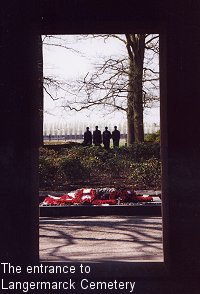 Langemarck
was the scene of heavy fighting throughout October and November
1914. In April 1915 the village fell into German hands following
the first gas attack and was only recaptured by the British on
16th August 1917 during Third Ypres. Once again the village fell
into German hands during the great German push of Spring 1918.
The Belgians finally retook it on 28th September 1918. Langemarck
was the scene of heavy fighting throughout October and November
1914. In April 1915 the village fell into German hands following
the first gas attack and was only recaptured by the British on
16th August 1917 during Third Ypres. Once again the village fell
into German hands during the great German push of Spring 1918.
The Belgians finally retook it on 28th September 1918.
After
the war the Belgian authorities were less than willing to give
up land to the German enemy. Langemarck Cemetery is the only
German one in the Salient and contains over 44,000 burials,
concentrated from many smaller cemeteries in the Salient. An oak
panel just inside the entrance to the cemetery lists the names
of the German missing.
The
first large headstone encountered once the visitor enters the
cemetery marks a mass grave containing 25,000 soldiers that is
planted with flowering shrubs. Bronze panels are carved with the
names and regiments of the soldiers in the grave.
At
the rear of the cemetery is a sculpture, by Professor Emil
Krieger, of four mourning figures seen in shadow from the front
of the cemetery. Dotted around the cemetery are small ceremonial
crosses; they do not signify burials. Flat stones mark burial
plots. Often several soldiers share a grave.
Along
the north wall are the remains of a number of large German
blockhouses. |
The
afternoon's first stop was at one of only four German war cemeteries. It
is at Langemarck and contains the remains of over 44,000 Germans killed
in the Salient. It has a very different appearance from the British and
Commonwealth cemeteries that we have visited. Entering through a dark
stone archway one is immediately faced with a large oak wreath
fabricated in black metal. Beyond this is a large bed of roses that
covers the mass grave of 25,000 soldiers. Behind and to both sides is a
grass lawn broken by hundreds of flat black slabs covering the graves of
yet more soldiers. Each slab bears the name of several men. Some carry
only four or six names while others can have up to twenty men lying
beneath them. Scattered among the slabs are groups of heavy black stone
crosses. To the right are the remains of old German bunkers. These too
contain many graves. Beyond the wreath, the rose bed and the lawn, at
the furthest extremity of the cemetery, is a group of four dark, brooding
figures. They stand there in the distance, little more than silhouettes,
a reminder of the sad men whose remains surround us and of those who had
no remains to be interred. The Germans have no Menin Gate, no Tyne Cot
and no Thiepval. They lost the war and part of the revenge exacted by
the victorious nations was this sombre disposal of their vanquished
dead. It was to settle in the German subconscious and fester there. Most
German towns still have a Langemarckstrasse and it was significant that
in 1940 Adolph Hitler chose to come to this cemetery to announce the
fall of Belgium to his then victorious armies.
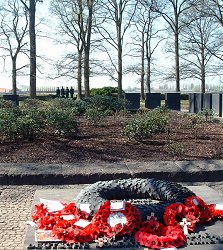 The
cemetery grounds are punctuated by several large oak trees which, when
in full leaf, must cast an oppressive shade on the scene. However, on
the hot, sunny spring afternoon that we visited, with the leaves still
no more than promising buds and the open branches casting intricate
dancing patterns on the grass, the scene was one of pleasant contrasts
which added to the sadness rather than distracting from it. The young
green of the grass and the brightness of the surrounding Belgian
countryside gave emphasis to the darkness of the bronze wreath, the
memorial stones and the strange black figures. The
cemetery grounds are punctuated by several large oak trees which, when
in full leaf, must cast an oppressive shade on the scene. However, on
the hot, sunny spring afternoon that we visited, with the leaves still
no more than promising buds and the open branches casting intricate
dancing patterns on the grass, the scene was one of pleasant contrasts
which added to the sadness rather than distracting from it. The young
green of the grass and the brightness of the surrounding Belgian
countryside gave emphasis to the darkness of the bronze wreath, the
memorial stones and the strange black figures.
I
particularly noticed three things about this cemetery that will stay in
my mind for some time. Firstly, the metal wreath was surrounded by
several wreaths of bright red poppies. Each of these wreaths had been
laid by British visitors, for the most part by schoolchildren. It is
good that our children should see and honour all those who lost their
lives in this war and not just the British soldiers. In the whole
cemetery there was only one wreath laid by a German visitor. One of the
graves over by the Bunker had a wreath but not of poppies. It was a
smaller version of the black metal one by the entrance, made of oak
leaves, brown and hard and dry.
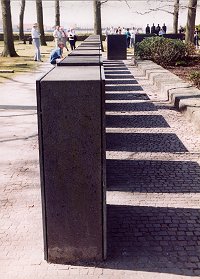 Also
strangely apparent as I walked among the black memorial stones covering
the graves was the absence of any officers' names. The highest rank I
discovered was sergeant-major. This mirrors the situation I have noticed
in the French cemeteries we have visited. Where did they lay their
officers? It contrasts so strongly with the equality among the British
and Commonwealth dead, where officers lie among other ranks without
precedence and a VC winner can lie next to a more ordinary soul. Also
strangely apparent as I walked among the black memorial stones covering
the graves was the absence of any officers' names. The highest rank I
discovered was sergeant-major. This mirrors the situation I have noticed
in the French cemeteries we have visited. Where did they lay their
officers? It contrasts so strongly with the equality among the British
and Commonwealth dead, where officers lie among other ranks without
precedence and a VC winner can lie next to a more ordinary soul.
My
final observation is very ironic. As I gazed at the brooding figures at
the back of the graveyard I became increasingly struck by one
overpowering thought; how like some of the images generated by the
Holocaust they were. These black figures could so easily have
represented a group of concentration camp victims. I wonder if Hitler
noticed this during his visit?
As a
final note to this cemetery, the German bunkers were also the place
where a Victoria Cross was won by Private Frederick Dancox of 4th
Battalion, Worcestershire Regiment. During an attack on 9th October 1917
the Worcesters' advance was considerably hampered by a German
machine-gun firing from the concrete emplacement. The citation goes on
to say:
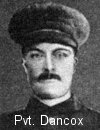 |
Private
Dancox who was one of a party of 10 detailed as moppers-up, managed to
work his way through the barrage and entered the 'pill box' from the
rear, threatening the garrison with a Mills bomb. Shortly afterwards he
reappeared with a machine-gun under his arm and about 40 of the enemy.
He brought the gun back to our position and kept it in action throughout
the day.
|
TYNE
COT CEMETERY
|
Tyne
Cot is the largest British war cemetery in the world. 11,908
graves are registered. On the wall at the back of the cemetery
are the names of 34,927 soldiers who have no known grave and who
died from August 1917 to the end of the war, a continuation of
the names inscribed on the Menin Gate.
The
long slogging fight of the Third Battle of Ypres began on July
31st 1917 and ended with the capture of the village of
Passchendaele on November 6th. The battle entered its final
stage when the Germans were cleared from the Passchendaele
Ridge.
By
the beginning of October the advancing 3rd Australian Division
had captured the area near to an old farm building which was
marked on British maps as Tyne Cottage or Tyne Cot. The area
near the barn had been very heavily defended by several concrete
machine-gun positions. It was these pill boxes that had given the
location its map name after an alleged reference by
Northumberland Fusiliers to their likeness to Tyneside cottages.
As the general advance in the area progressed, the British began
to use the largest bunker as a dressing station and began a
cemetery outside. The dressing station and its cemetery
continued in use until the German advance of March 1918 when the
area fell into German hands again. In due course the British
made their final advance and regained the area. By
the end of the war there were about 300 burials in the cemetery
behind the blockhouse plus other isolated burials in the
surrounding area.
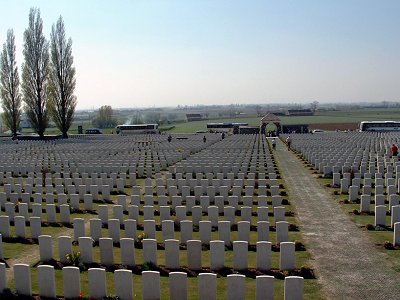
After
the war the decision was taken to use the site as a
concentration cemetery for the area. Sir Herbert Baker designed
its final layout. He incorporated five of the German blockhouses
into his design although only two of them are obviously visible.
They stand to the left and right of the main cemetery area. When
King George V visited the battlefields in 1922, he was at Tyne
Cot while the construction works were still in progress. He
suggested that the Cross of Sacrifice should be built over the
largest of the blockhouses. The cross now stands much higher
than is usual, above a stepped pyramid of white stone, which
covers much of the blockhouse. In the side of the pyramid facing
the entrance gate a small section of the original concrete is
still visible. The two remaining bunkers are hidden from view
under each of the two domed pavilions at either end of the far
wall. |
If
Langemarck made a statement about the German losses around Ypres, our
next stop was intended to do the same for the British and Commonwealth
dead. Tyne Cot cemetery is built on land captured by the Australians in
1917.
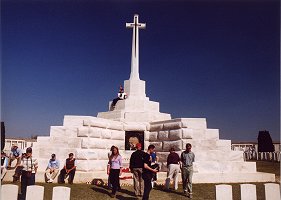 |
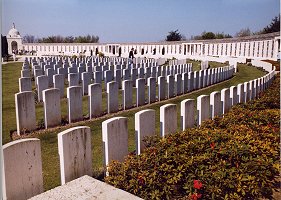 |
The
cemetery is equally as memorable as the one at Langemarck but for
different reasons. It is a grand interpretation of the basic style
adopted for all British and Commonwealth war cemeteries. As you enter
through the usual brick and stone arch, the vista stretches ahead and to
each side. It is impossible to take it in at one glance. Rather it
offers a staggering panorama of row after row of straight white
headstones. At the centre, raised above the surrounding graves, is the
white stone Cross of Sacrifice bearing its dark bronze sword. Beyond
this is the plain Stone of Remembrance and finally, bringing the scene to
a conclusion, is the surrounding wall with its endless parade of
blindingly white panels naming the lost men. A counterpoint to all this
white was the green of the grass and the bright yellows and reds of the
fresh spring flowers between the headstones. The only dark shades in the
cemetery are the two visible German bunkers that now stand stark and
grey to either side of the entrance. The headstones all present their
plain side to the entrance but their faces look in the same direction as
did the eyes of the men who now lie beneath them - towards their enemy.
As we
sat below the cross Andy and Pete explained how the cemetery came to be
here, how it got its name and the reasons for its dramatic, almost
theatrical design. Finally Andy read E A Mackintosh's poem, "In
Memoriam".
|
In
Memoriam
By
Ewart Alan Mackintosh
(killed in action 21 November 1917 aged 24)
So
you were David's father,
And
he was your only son,
And
the new-cut peats are rotting
And
the work is left undone,
Because
of an old man weeping,
Just
an old man in pain,
For
David, his son David,
That
will not come again.
Oh,
the letters he wrote you,
And
I can see them still,
Not
a word of the fighting,
But
just the sheep on the hill
And
how you should get the crops in
Ere
the year get stormier,
And
the Bosches have got his body,
And
I was his officer.
You
were only David's father,
But
I had fifty sons
When
we went up in the evening
Under
the arch of the guns,
And
we came back at twilight -
O
God! I heard them call
To
me for help and pity
That
could not help at all.
Oh,
never will I forget you,
My
men that trusted me,
More
my sons than your fathers',
For
they could only see
The
little helpless babies
And
the young men in their pride.
They
could not see you dying,
And
hold you while you died.
Happy
and young and gallant,
They
saw their first-born go,
But
not the strong limbs broken
And
the beautiful men brought low,
The
piteous writhing bodies,
They
screamed 'Don't leave me, sir',
For
they were only your fathers
But
I was your officer. |
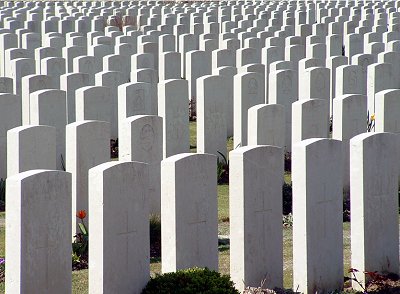
The
names of the following men from Marple are inscribed on the walls of the
Tyne Cot Memorial (with the dates of their death): -
| Robert
Clifford Dawson |
16/08/1917 |
| William Arthur
Stott |
16/08/1917 |
| William Austin |
22/10/1917 |
| Ernest
Greenhalgh |
22/10/1917 |
| Samuel
Thelwall |
25/10/1917 |
| Josiah Bennett |
18/04/1918 |
| Egbert
Mackereth |
30/04/1918 |
Moving
on, we made a brief stop in the village of Passchendaele to view a
memorial stained glass window before continuing on to Hill 62 and
Sanctuary Wood.
HILL
62 and SANCTUARY WOOD
|
In
October 1914 the wood was a quiet area - hence it became known
as Sanctuary Wood. But by 1915 it had become part of the front
line. In the summer of 1916 the Germans launched a number of
attacks in the area but were eventually driven back by the
Canadians who retook Hill 62 (so named because it was 62 metres
high - a considerable height in this area).
It
was in this area that the first flame-thrower attack by the
Germans in the Great War took place and where Captain Noel
Chavasse won his Military Cross in June 1915. He took part in an
attack on Sanctuary Wood in September 1915 and in a letter home
described it as:
…the
dreariest and most dreadful spot in the whole of that desolation
of abomination called the firing line. |
This
place is a bizarre mix of memorial and mammon. Behind his bar and its
associated museum, and for the price of a few Euros, the owner will
grant you admittance to his own private trench system.
First
comes the dusty, rusty museum. In a first room are a number of ancient
stereoscopic viewers. If you gaze carefully through the twin eyepieces
you can clearly see images of the war in three dimensions. The pictures
seem to have been carefully chosen for their horror. Scenes of dead and
mangled men and animals, all lying amid the dirt and squalor of the war,
follow each other in quick and seemingly endless succession as you turn
the knob on the side of the viewer. The strange, cut-out effect lent by
the ancient 3D image and the faded sepia hue of the ancient photographs
cannot detract from the frightfulness of what they depict. Despite their
similarity to the old end-of-the-pier What The Butler Saw machines
these viewers offer a very different experience.
The
rest of this room is crammed with old, dark glass cases filled, in no
particular order or system, with all kinds of mementos of the fighting.
Helmets, weapons, equipment, cap badges - all are crammed in behind the
grimy glass. Moving to a second room we discover further huge piles of
rusting relics - shells, guns, bayonets…
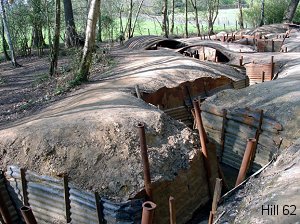 From
this last room we gained the outdoors. Here we found that we had stepped
back into an extremely sanitised facsimile of the war. Actually these
are the only set of original trenches preserved virtually unchanged
within the Ypres Salient and give a good idea of what the trench system
looked like with saps, listening posts, dugouts, shell holes and blasted
trees all left as they were at the end of the war. There is also an
underground passageway dug towards the German lines with the aim of
placing explosives under their trenches. The trenches wind along between
trees and shell holes in all their sandbagged, duck-boarded, rusty
corrugated iron pathos. Most of the trees are obviously post war but
enough blasted and bullet scarred stumps remain to give a suitable
effect to the scene. But the sun shone, the newer trees grew and leafed
and only the sounds of chattering visitors and playing children broke
the silence. The trenches may still be damp and muddy but we could
remain clean and dry by walking above them in what had been no-man's-land. Their previous occupants may never have seen these trenches from
this perspective, upright and in the full light of day. They would have
been forced to stay down there in the sticky mud, hiding from the
artillery that had left the shell holes that the present owner now so
diligently keeps clear of debris. Only on the darkest nights might they
venture out and then only at a hunch as they set out on patrol or to
mend the wire. To them the trenches were a reluctant home, a defence, a
place from which to retreat or leave when wounded. I wonder if they
would understand people paying money to be there or comprehend the
attitude of many of the visitors as they played among the old blasted
trees and tunnels? From
this last room we gained the outdoors. Here we found that we had stepped
back into an extremely sanitised facsimile of the war. Actually these
are the only set of original trenches preserved virtually unchanged
within the Ypres Salient and give a good idea of what the trench system
looked like with saps, listening posts, dugouts, shell holes and blasted
trees all left as they were at the end of the war. There is also an
underground passageway dug towards the German lines with the aim of
placing explosives under their trenches. The trenches wind along between
trees and shell holes in all their sandbagged, duck-boarded, rusty
corrugated iron pathos. Most of the trees are obviously post war but
enough blasted and bullet scarred stumps remain to give a suitable
effect to the scene. But the sun shone, the newer trees grew and leafed
and only the sounds of chattering visitors and playing children broke
the silence. The trenches may still be damp and muddy but we could
remain clean and dry by walking above them in what had been no-man's-land. Their previous occupants may never have seen these trenches from
this perspective, upright and in the full light of day. They would have
been forced to stay down there in the sticky mud, hiding from the
artillery that had left the shell holes that the present owner now so
diligently keeps clear of debris. Only on the darkest nights might they
venture out and then only at a hunch as they set out on patrol or to
mend the wire. To them the trenches were a reluctant home, a defence, a
place from which to retreat or leave when wounded. I wonder if they
would understand people paying money to be there or comprehend the
attitude of many of the visitors as they played among the old blasted
trees and tunnels?
Back
in his bar the owner was increasing his fortune as we enjoyed a couple
of beers in the sun before returning to Ypres. Is it significant that
this busy tourist site, constantly full of curious visitors, issues no
tickets and seems to keep no records of the money taken at the
turnstile?
As
soon as we got back to the hotel Andy whisked off those who had shown an
interest to a couple of chocolate shops. Belgium is justifiably famous
for its chocolate and I certainly was not ready to return to my wife
without some examples of their art.
Dinner
was eaten at Vivaldi's on the other side of the Market Square
from the restaurant we visited last night. I had some excellent pork
fillet with a salad and a good bottle of red wine.
|